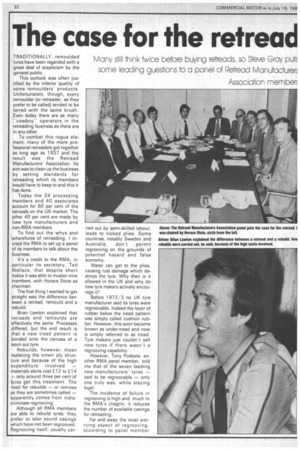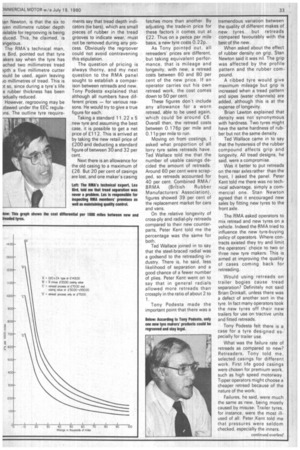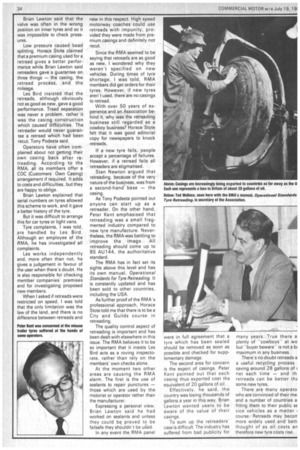The case for the retread
Page 34

Page 35

Page 36

If you've noticed an error in this article please click here to report it so we can fix it.
Many still think -wice before buying retreads, so Steve Gray put some leading guestions to a panel of Retread Manufacturer
Association member
TRADITIONALLY, remoulded tyres have been regarded with a great deal of scepticism by the general public.
This outlook was often justified by the inferior quality of some remoulders' products. Unfortunately, though, every remoulder (or retreader, as they prefer to be called) tended to be tarred with the same brush. Even today there are as many cowboy' operators in the retreading business as there are in any other.
To combat this rogue element, many of the more professional retreaders got together as long ago as 1937 and the result was the Retread Manufacturers' Association. Its aim was to clean up the business by setting standards for retreading which its members would have to keep to and this it has done.
Today the 34 processing members and 40 associates account for 60 per cent of the retreads on the UK market. The other 40 per cent are made by new tyre manufacturers and non-RMA members.
To find out the whys and .wherefores of retreading, I invited the RMA to set up a panel of its members to talk about the business.
It's a credit to the RMA, in particular its secretary, Ted Wallace, that despite short notice it was able to muster nine members, with Horace Stote as chairman.
The first thing I wanted to get straight was the difference between a retread, remould and a rebuild.
Brian Lawton explained that retreads and remoulds are effectively the same. Processes differed, but the end result is that a new tread pattern is bonded onto the carcass of a worn out tyre.
Rebuilds, however, mean replacing the crown ply struc ture and because of the high expenditure involved — materials alone cost £.12 to £14 — only around three per cent of tyres get this treatment. The need for rebuilds — or remixes as they are sometimes called — apparently comes from indiscriminate regrooving.
Although all RMA members are able to rebuild tyres, they prefer to take sound casings which have not been regrooved. Regrooving itself, usually car ried out by semi-skilled labour, leads to nicked plies. Some countries, notably Sweden and Australia, don't permit regrooving on the grounds of potential hazard and false• economy.
Water can get to the plies, causing rust damage which de stroys the tyre. Why then is it allowed in the UK and why do new tyre makers actively encourage it?
Before 1972/3 no UK tyre manufacturer said its tyres were regroovable. Indeed the layer of rubber below the tread pattern was simply called cushion rub ber. However, this soon became known as under-tread and now is simply referred to as tread.
Tyre makers just couldn't sell new tyres if there wasn't a regrooving capability.
However, Tony Podesta, another RMA panel member, told me that of the seven leading new manufacturers' tyres — said to be regroovable — only one truly was, while staying legal.
The incidence of failure in regrooving is high and, much to the RMAN's chagrin, it reduces the number of available casings for retreading.
Far and away the most worrying aspect of regrooving, according to panel member tan Newton, is that the six to iven millimetre rubber depth iailable for regrooving is being .cluced. This, he claimed, is 3ngerous.
The RMA's technical man, Bird, pointed out that tyre akers say when the tyre has ,ached two millimetres tread .pth a five millimetre cutter iould be used, again leaving 10 millimetres of tread. This is )t so, since during a tyre's life e rubber thickness has been Adually reduced.
However, regrooving may be rtlawed under the EEC regula)ns. The outline tyre require ments say that tread depth indicators (tie bars), which are small pieces of rubber in the tread grooves to indicate wear, must not be removed during any process. Obviously the regroover could not avoid contravening this stipulation.
The question of pricing is always thorny, and my next question to the RMA panel sought to establish a comparison between retreads and new. Tony Podesta explained that although all numbers have different prices — for various reasons. He would try to give a true figure for each.
Taking a standard 11.22 x 5 new tyre and assuming the best case, it is possible to get a net price of £112. This is arrived at by taking the new retail price of £200 and deducting a standard figure of between 30 and 32 per cent.
Next there is an allowance for the old casing to a maximum of £26. But 20 per cent of casings are lost, and one maker's casing fetches more than another. By adjusting the trade-in price for these factors it comes out at £22. Thus on a pence per mile basis, a new tyre costs 0.22p.
As Tony pointed out, all retreaders' prices are different, but taking equivalent performance, that is mileage and longevity, with new, a retread costs between 60 and 80 per cent of the new price. If an operator carries out his own retread work, the cost comes down to 50 per cent.
These figures don't include any allowance for a worn retread, able to be used again, which could be around £6. Overall then, the retread costs between 0.176p per mile and 0.11p per mile to run.
Moving on from costings, I asked what proportion of all lorry tyre sales retreads have. Ted Wallace told me that the number of usable casings decided the amount of retreads. Around 60 per cent were scrapped, so retreads accounted for 40 per cent. Combined RMA/ BR MA (British Rubber Manufacturers' Association), figures showed 39 per cent of the replacement market for cars and vans.
On the relative longevity of cross-ply and radial-ply retreads compared to their new counterparts, Peter Kent told me the percentage was the same for both, Ted Wallace joined in to say that the steel-braced radial was a godsend to the retreading industry. There is, he said, less likelihood of separation and a good chance of a fewer number of plies. Peter Kent went on to say that in general radials allowed more retreads than crossply in the ratio of about 2 to Tony Podesta made the important point that there was a tremendous variation between the quality of different makes of new tyres, but retreads compared favourably with the best of the new.
When asked about the effect of rubber density on grip, Stan Newton said it was nil. The grip was affected by the profile pattern and the rubber compound.
A ribbed tyre would give maximum mileage but grip is increased when a tread pattern and sipes (water channels) are added, although this is at the expense of longevity.
Brian Lawton explained that density was not synonymous with hardness. Two tyres might have the same hardness of rubber but not the same density.
Ted Wallace came in to say that the hysteresis of the rubber compound affects grip and longevity. All tread designs, he said, were a compromise.
Was it better to put retreads on the rear axles rather than the front, I asked the panel. Peter Kent told me there was no technical advantage, simply a commercial one. Stan Newton agreed that it encouraged new sales by fitting new tyres to the front axle.
The RMA asked operators to mix retread and new tyres on a vehicle. Indeed the RMA tried to influence the new tyre-buying policy of operators. Where contracts existed they try and limit the operators' choice to two or three new tyre makers. This is aimed at improving the quality of cases coming back for retreading.
Would using retreads on trailer bogies cause tread separation? Definitely not said Brian Drinkall, unless there was a defect of another sort in the tyre. In fact many operators took the new tyres off their new trailers for use on tractive units and fitted retreads.
Tony Podesta felt there is a case for a tyre designed especially for trailer use.
What was the failure rate of retreads as compared to new? Retreaders, Tony told me, selected casings for different work. First life good casings were chosen for premium work, such as high speed motorway. Tipper operators might choose a cheaper retread because of the nature of the work.
Failures, he said, were much the same as new, being mostly caused by misuse. Trailer tyres, for instance, were the most illused of all. Peter Kent told me that pressures were seldom checked, especially the inners. Brian Lawton said that the valve was often in the wrong position on inner tyres and so it was impossible to check pressures.
Low pressure caused bead splitting, Horace Stote claimed that a premium casing used for a retread gives a better performance while Brian Lawton said retreaders gave a guarantee on three things — the casing, the retread process, and the mileage.
Les Bird insisted that the retreads, although obviously not as good as new, gave a good performance. Tread separation was never a problem, rather it was the casing construction which caused difficulties. The retreader would never guarantee a retread which had been recut, Tony Podesta said.
Operators have often complained about not getting their own casing back after re treading. According to the RMA, all its members offer a COC (Customers Own Casing) arrangement if required. It adds to costs and difficulties, but they are happy to oblige.
Brian Lawton explained that serial numbers on tyres allowed this scheme to work, and it gave a better history of the tyre.
But it was difficult to arrange this for car tyres or light vans.
Tyre complaints, I was told, are handled by Les Bird.
Although an employee of the RMA, he has investigated all complaints.
Les works independently and, more often than not, he gives a iudgement in favour of the user when there's doubt. He is also responsible for checking member companies' premises and for investigating proposed new members.
When I asked if retreads were restricted on speed, I was told that the only limitation was the law of the land, and there is no difference between retreads and new in this respect. High speed motorway coaches could use retreads with impunity, provided they were made from premium casings and definitely not recut Since the RMA seemed to be saying that retreads are as good as new, I wondered why they weren't specified on new vehicles. During times of tyre shortage, I was told, RIVIA members did get orders for their tyres. However, if new tyres aren't used, there are no casings to retread.
With over 50 years of experience and an Association behind it, why was the retreading business still regarded as a cowboy business? Horace State felt that it was good editorial copy for newspapers to knock retreads.
If a new tyre fails, people accept a percentage of failures. However, if a retread fails all retreaders are stigmatised.
Stan Newton argued that retreading, because of the very nature of the business, was from a second-hand base — the casing.
As Tony Podesta pointed out anyone can start up as a retreader. On the other hand, Peter Kent emphasised that retreading was a small fragmented industry compared to new tyre manufacture. Nevertheless, the RMA was battling to improve the image. All retreading should come up to BS AU 144, the authoritative standard.
The RMA has in fact set its sights above this level and has its own manual, Operational Standards for Tyre Retreading. It is constantly updated and has been sold to other countries, including the USA.
As further proof of the AMA's professional approach, Horace Stote told me that there is to be a City and Guilds course in retreading.
The quality control aspect of retreading is important and has been dealt with elsewhere in this issue. The RMA believes it to be so important that it insists Les Bird acts as a roving inspectorate, rather than rely on the members' own checks alone.
At the moment two other areas are causing the RMA alarm, The first is the use of sealants to repair punctures — those which are used by the motorist or operator rather than the manufacturer.
Expressing a personal view, Brian Lawton said he had worked on sealants and unless they could be proved to be failsafe they shouldn't be uSed.
In any event the RMA panel were in full agreement that a tyre which has been sealed should be removed as soon as possible and checked for supplementary damage.
The second area for concern is the export of casings. Peter Kent pointed out that each casing thus exported cost the equivalent of 20 gallons of oil.
Effectively, he said, the country was losing thousands of gallons a year in this way Brian Lawton wanted users to be aware of the value of their casings.
To sum up the retreaders' case is difficult. The industry has suffered from bad publicity for
many years. True there a plenty of -cowboys" at wo but "buyer bewareis not a iN maximum in any business.
There's no doubt retreads a a useful recycling process saving around 28 gallons of net each time — and th retreads can be better thz some new tyres.
There are many operato who are convinced of their me and a number of countries a fitting them to their public SE vice vehicles as a matter course: Retreads may becorT more widely used and bettl thought of as oil costs an therefore new tyre costs rise.








































































































































